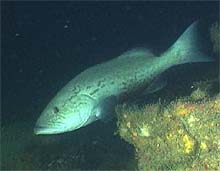
Gag is one of the dominant economically important reef fish found on the shelf edge. Click image for larger view.
Shelf and Shelf-Edge Reefs of the West Florida Shelf
Felicia Coleman, Ph.D., Marine Ecologist
Institute for Fishery Resource Ecology,
Department of Biological Science, Florida State University
Description
Along the edge of the West Florida continental shelf exists a broad band of "drowned reefs" or "fossil reefs" at water depths ranging from approximately 50 m to over 120 m. These paleo reefs are important ecologically as areas of high biodiversity and as source areas supporting the spawning aggregations of the more economically important reef fish species of the southeastern United States. Yet virtually nothing is known of these ecosystems. Given the potential for human-induced threats to these habitats from fishing impact, oil and gas exploration and development, and water rediversion projects, the need is acute to identify and classify the area into spatially and temporally specific regions.
Research and Education Objectives
Because the shelf-edge reef habitats of the West Florida shelf have been fished for over 100 years, it is possible that direct as well as indirect or incidental impacts have affected their benthic communities and habitat features. Direct effects include anchor, longline, and trawl impacts. Indirect effects may include trophic cascades resulting from the removal of top-level predators like groupers and snappers from the system. Some of these sites have already been mapped using acoustic techniques, such as side-scan sonar and multibeam imagery. This work, conducted by the U. S. Geological Survey, provides the geomorphological basis on which benthic habitat characterization can be developed. The mission objectives for this leg of the SSE Summer 2001 Cruise were to conduct systematic surveys of the different habitat features, with particular emphasis on reef fish spawning aggregation sites throughout this region, and to collect sediment and biological samples for identification and classification of habitat types. Educators will use data from this leg of the cruise to develop an on-line interactive outreach program, with particular components showing the connectivity between inshore and offshore environments.
Key Habitats
- Deep rocky reefs
- Ledges
- Paleo shoreline
- Drowned patch reefs pinnacles
- Sand waves
- Hard bottom chemosynthetic communities
- Submarine canyons
- Fault scarps soft sediments
- Algal/sponge communities
- Brine seeps/flows
Key Species
Roughtongue Bass Pronotogrammus martinicensis Red Barbier Hemanthias vivanus Spanish Flag Gonioplectrus hispanus Creole fish Paranthias furcifer Red Snapper Lutjanus campechanus Vermilion snapper Rhomboplites aurorubens Scamp Mycteroperca phenax Gag Mycteroperca microlepis Red grouper Epinephelus morio Amberjack Seriola dumerili Almaco Jack Seriola rivoliana Yellowtail reef fish Chromis enchrysurus Black Corals Antipatharians
Protected Areas
Name |
Area (nm2) |
Date established |
Other comments |
| Madison Swanson Fishery Reserve | 115 |
2000 |
- 4 year experimental closure |
| Steamboat Lumps Fishery Reserve | 104 |
2000 |
- 4 year experimental closure |
| Florida Middle Grounds Habitat Area of Particular Concern (HAPC) | 348 |
1984 |
- permanent site - year-round - protects coral habitat - open to all fishing except with the following gears: bottom longlines, traps, pots, and bottom trawls |
Sign up for the Ocean Explorer E-mail Update List.











































